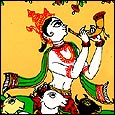 |
|
| 网站指南 | |
| · |
节 日 |
| · |
圣地 |
| · |
画廊 |
| · |
音乐 |
| · |
饮食 |
| · |
文化 |
| · |
首页 |
| Jagannatha Puri | |
|
Jagannatha Puri is approximately 60km from Orissa's state capital, Bhubaneswar. It is considered by many Hindus to be one of the four holiest places (dhamas) and is particularly revered by Vaisnavas as the home of Krishna in His form of Jagannatha, Lord of the Universe, as well as being the site of many of the pastimes of Sri Caitanya Mahaprabhu. Puri is also known as 'Sri Purusottama Dhama' or 'Martya Vaikuntha', the abode of Lord Visnu on earth. Other names are Sriksetra (best of all sacred centres), Purusottama Ksetra (the abode of the supreme being), Nilachal, Nalagiri, Sankha Ksetra, and Jagannatha Dhama. The Temple of Lord Jagannatha is one of the major temples in India. The worship of Lord Jagannatha is so ancient that there is no accurate record of how long it has been going on. It is strictly forbidden for non-Hindus to enter the Jagannatha temple. Sri Ramanuja visited Puri between 1107 and 1117 AD and stayed for some time. Visnuswami visited Puri in the second half of the 12th century and established a matha near Markandeswar Tank, called Vishnuswami Matha. Nimbarka Acarya also made a pilgrimage to Puri, and Srila Prabhupada visited in January 1977. A major reason that Puri is so important to Gaudiya Vaisnavas is because Lord Caitanya spent so much time here. Many of His pastimes with His most intimate associates took place at in this area. Puri Highlights Lord Jagannatha Temple Once a year Lord Jagannatha, along with His brother, Baladeva, and sister, Subhadra, are taken out of the temple and pulled on huge chariots through the streets of Puri. It is from these huge chariots that the English word 'juggernaut' comes. Millions of devotees attend this festival every year, including the King of Puri, who sweeps the path in front of Lord Jagganatha's cart. Until recently, almost the entire temple was covered in white plaster, so much so that European sailors in previous centuries used it as a navigation point, referring to it as the 'White Pagoda' in contrast to the 'Black Pagoda' of Konarak, further up the coast. Gundicha Mandir (Temple) Non-Hindus can walk within the walls and see the beautiful garden, but they are not allowed in the temple building. |